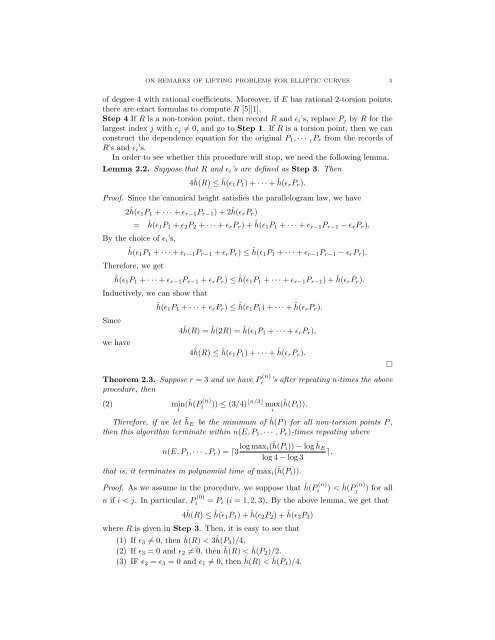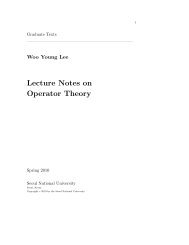ON REMARKS OF LIFTING PROBLEMS FOR ELLIPTIC CURVES 1 ...
ON REMARKS OF LIFTING PROBLEMS FOR ELLIPTIC CURVES 1 ...
ON REMARKS OF LIFTING PROBLEMS FOR ELLIPTIC CURVES 1 ...
Create successful ePaper yourself
Turn your PDF publications into a flip-book with our unique Google optimized e-Paper software.
<strong>ON</strong> <strong>REMARKS</strong> <strong>OF</strong> <strong>LIFTING</strong> <strong>PROBLEMS</strong> <strong>FOR</strong> <strong>ELLIPTIC</strong> <strong>CURVES</strong> 5<br />
of degree 4 with rational coefficients. Moreover, if E has rational 2-torsion points,<br />
there are exact formulas to compute R [5][1].<br />
Step 4 If R is a non-torsion point, then record R and ɛ i ’s, replace P j by R for the<br />
largest index j with ɛ j ̸= 0, and go to Step 1. If R is a torsion point, then we can<br />
construct the dependence equation for the original P 1 , · · · , P r from the records of<br />
R’s and ɛ i ’s.<br />
In order to see whether this procedure will stop, we need the following lemma.<br />
Lemma 2.2. Suppose that R and ɛ i ’s are defined as Step 3. Then<br />
4ĥ(R) ≤ ĥ(ɛ 1P 1 ) + · · · + ĥ(ɛ rP r ).<br />
Proof. Since the canonical height satisfies the parallelogram law, we have<br />
2ĥ(ɛ 1P 1 + · · · + ɛ r−1 P r−1 ) + 2ĥ(ɛ rP r )<br />
= ĥ(ɛ 1P 1 + ɛ 2 P 2 + · · · + ɛ r P r ) + ĥ(ɛ 1P 1 + · · · + ɛ r−1 P r−1 − ɛ r P r ).<br />
By the choice of ɛ i ’s,<br />
ĥ(ɛ 1 P 1 + · · · + ɛ r−1 P r−1 + ɛ r P r ) ≤ ĥ(ɛ 1P 1 + · · · + ɛ r−1 P r−1 − ɛ r P r ).<br />
Therefore, we get<br />
ĥ(ɛ 1 P 1 + · · · + ɛ r−1 P r−1 + ɛ r P r ) ≤ ĥ(ɛ 1P 1 + · · · + ɛ r−1 P r−1 ) + ĥ(ɛ rP r ).<br />
Inductively, we can show that<br />
ĥ(ɛ 1 P 1 + · · · + ɛ r P r ) ≤ ĥ(ɛ 1P 1 ) + · · · + ĥ(ɛ rP r ).<br />
Since<br />
we have<br />
4ĥ(R) = ĥ(2R) = ĥ(ɛ 1P 1 + · · · + ɛ r P r ),<br />
4ĥ(R) ≤ ĥ(ɛ 1P 1 ) + · · · + ĥ(ɛ rP r ).<br />
Theorem 2.3. Suppose r = 3 and we have P (n)<br />
i<br />
’s after repeating n-times the above<br />
procedure, then<br />
(n)<br />
(2)<br />
min(ĥ(P i<br />
i )) ≤ (3/4) ⌊n/3⌋ max (ĥ(P i)).<br />
i<br />
Therefore, if we let ĥE be the minimum of ĥ(P ) for all non-torsion points P ,<br />
then this algorithm terminate within n(E, P 1 , · · · , P r )-times repeating where<br />
n(E, P 1 , · · · , P r ) = ⌈3 log maxi(ĥ(P i)) − log ĥE ⌉,<br />
log 4 − log 3<br />
that is, it terminates in polynomial time of max i (ĥ(P i)).<br />
(n)<br />
(n)<br />
Proof. As we assume in the procedure, we suppose that ĥ(P i ) < ĥ(P j<br />
) for all<br />
n if i < j. In particular, P (0)<br />
i = P i (i = 1, 2, 3). By the above lemma, we get that<br />
4ĥ(R) ≤ ĥ(ɛ 1P 1 ) + ĥ(ɛ 2P 2 ) + ĥ(ɛ 3P 3 )<br />
where R is given in Step 3. Then, it is easy to see that<br />
(1) If ɛ 3 ≠ 0, then ĥ(R) < 3ĥ(P 3)/4.<br />
(2) If ɛ 3 = 0 and ɛ 2 ≠ 0, then ĥ(R) < ĥ(P 2)/2.<br />
(3) IF ɛ 2 = ɛ 3 = 0 and ɛ 1 ≠ 0, then ĥ(R) < ĥ(P 1)/4.<br />
□













